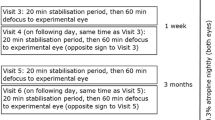Abstract
Purpose: To examine the retinal function with different electrophysiological methods in twelve Swedish patients on long-term treatment (2–10 years) with the anti-epileptic drug vigabatrin. Methods: Ophthalmological examination of twelve consecutive patients included testing of visual acuity, fundus inspection and fundus photography, kinetic perimetry, full-field ERG and multifocal ERG. Results: All patients had a visual acuity of 0.7 or better. Fundus inspection revealed no pathology except in one patient who had a pallor of the optic disc. All patients had a normal appearance of the macula. The result of kinetic perimetry was normal in five patients while seven patients had a concentric defect of the visual field. The 30 Hz flicker cone b-wave amplitude in the full-field ERG was abnormal in all of the seven patients with a visual field defect. None of the patients with normal visual fields had a reduction of the 30 Hz flicker cone b-wave amplitude. Six of the twelve patients had a reduced multifocal ERG response but without any correlation with visual field defect. Conclusion: Long-term treatment with vigabatrin seems to selectively reduce retinal cone function. The visual field defects in patients taking vigabatrin correlate with pathology in the full-field ERG (reduction of the cone b-wave amplitude). The results from this study indicate that electroretinography can be used for monitoring patients taking vigabatrin in a more objective manner than with visual field testing.
Similar content being viewed by others
References
Eke T, Talbot JF, Lawden MC. Severe persistent visual field constriction associated with vigabatrin. Br Med J 1997; 314: 180–1.
Backström JT, Hinke RL, Flicker MR. Severe persistent visual field constriction associated with vigabatrin. Br Med J 1997; 314: 1694–5.
Blackwell N, Hayllar J, Kelly G. Severe persistent visual field constriction associated with vigabatrin (letter). Br Med J 1997; 314: 1694.
Harding GA. Severe persistent visual field constriction associated with vigabatrin (letter). Br Med J 1997; 314: 1694.
Wilson EA, Brodie MJ. Severe persistent visual field constriction associated with vigabatrin (letter). Br Med J 1997; 314: 1693.
Wong ICK, Mawer GE, Sander JWAS. Severe persistent visual field constriction associated with vigabatrin. Br Med J 1997; 314: 1694–5.
Hammond EJ, Rangel RJ, Wilder BJ. Evoked potential monitoring of vigabatrin patients. Br J Clin Pract 1988; 61: 16–23.
Cosi V, Callieco R, Galimberti CA, Manni R, Tartara A, Mumford J, Perucca E. Effects of vigabatrin on evoked potentials in epileptic patients. Br J Clin Pharmac 1989; 27: 68.
Liegeois-Chauvel C, Marquis F, Gisselbrecht D, Pantieri R, Beumont D, Chauvel P. Effects of long-term vigabatrin on somatosensory-evoked potentials in epileptic patients. Epilepsia 1989; 30: 23–5.
Steinhoff J, Freudenthaler N, Paulus W. The influence of established and new epileptic drugs on visual perception. Epilepsy Res 1997; 29: 34–47.
Duckett T, Brigell MG, Ruckh S. Electroretinographic changes are not associated with loss of visual function in paediatric epileptic patients following treatment with vigabatrin. Invest Ophthalmol Vis Sci 1998; 39: 973.
Krauss GL, Johnson MA, Miller NR. Vigabatrin-associated retinal cone system dysfunction: electroretinogram and ophthalmologic findings. Neurology 1998; 50: 614–8.
Ruether K, Pung T, Kellner U, Schmitz B, Hartmann C, Seeliger M. Electrophysiologic evaluation of a patient with peripheral visual field constriction associated with vigabatrin. Arch Ophthalmol 1998; 116: 817–9.
Mackenzie R, Klistorner A. Severe persistent visual field constriction associated with vigabatrin. Asymptomatic as well as symptomatic defects occur with vigabatrin. Br Med J 1998; 316: 233.
Lawden MC, Eke T, Degg C, Harding GF, Wild JM. Visual field defects associated with vigabatrin therapy. J Neurol Neurosurg Psychiatry 1999; 67: 716–22.
Daneshvar H, Racette L, Coupland SG, Kertes PJ, Guberman A, Zackon D. Symptomatic and asymptomatic visual loss in patients taking vigabatrin. Ophthalmology 1999; 106: 1792–8.
Andréasson S, Ponjavic V, Abrahamson M, et al. Phenotypes in three Swedish families with X-linked retinitis pigmentosa caused by different mutations in the RPGR gene. Am J Ophthalmol 1997; 124: 95–102.
Sutter EE, Tran D. The field topography of ERG components in man, I: the photopic luminance response. Vision Res 1992; 32: 433–46.
Bearse MA, Sutter EE. Imaging localized retinal dysfunction with the multifocal electroretinogram. J Opt Soc Am A 1996; 13: 634–40.
Nousiainen I, Kälviäinen R, Mäntyjärvi M. Color vision in epilepsy patients treated with vigabatrin or carbamazepine monotherapy. Ophthalmology 2000; 107(5): 884–8.
Miller NL, Johnson MA, Paul SR, et al. Visual dysfunction in patients receiving vigabatrin: clinical and electrophysiologic findings. Neurology 1999; 53: 2082–7.
Author information
Authors and Affiliations
Rights and permissions
About this article
Cite this article
Ponjavic, V., Andréasson, S. Multifocal ERG and full-field ERG in patients on long-term vigabatrin medication. Doc Ophthalmol 102, 63–72 (2001). https://doi.org/10.1023/A:1017589301855
Issue Date:
DOI: https://doi.org/10.1023/A:1017589301855




